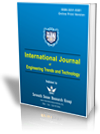Correlation Comparison of Kasami Sequences with Gold Codes and Novel Method of Generating Balanced Sequences from Kasami Codes
Correlation Comparison of Kasami Sequences with Gold Codes and Novel Method of Generating Balanced Sequences from Kasami Codes |
||
 |
 |
|
| © 2025 by IJETT Journal | ||
| Volume-73 Issue-2 |
||
| Year of Publication : 2025 | ||
| Author : M. Dileep Reddy, G. Sreenivasulu |
||
| DOI : 10.14445/22315381/IJETT-V73I2P111 | ||
How to Cite?
M. Dileep Reddy, G. Sreenivasulu, "Correlation Comparison of Kasami Sequences with Gold Codes and Novel Method of Generating Balanced Sequences from Kasami Codes," International Journal of Engineering Trends and Technology, vol. 73, no. 2, pp. 135-140, 2025. Crossref, https://doi.org/10.14445/22315381/IJETT-V73I2P111
Abstract
This paper presents the total number of kasami codes generated for each valid tap of ‘n’ bit (n is even) linear feedback shift register, generalised formulae to evaluate the total number of type 1 and type 2 kasami codes and the improvement in peak value of autocorrelation function side lobe for kasami codes with respect to the gold sequences. Also, the improvement in peak cross-correlation function for Kasami codes w.r.t. gold codes is also evaluated. The objective of this paper is to present a new method for converting non-balanced kasami codes of length to balanced codes of higher length.
Keywords
Autocorrelation side lobe peak, Normalised cross-correlation, Gold sequences, Kasami codes, Balance property.
References
[1] D. Sri Kavya, and P. Siddaiah, “Implementation of Seven Finger RAKE Receiver using MRC Technique,” International Journal of Recent Technology and Engineering (IJRTE), vol. 8, no.3, pp. 1689-1693, 2019.
[CrossRef] [Publisher Link]
[2] I.A. Alimi, J.J. Popoola, and K.F. Akingbade, “A Power Efficient Rake Receiver for Interference Reduction in the Mobile Communication Systems,” International Journal of Electronics and Electrical Engineering, vol. 3, no. 6, pp. 501-505, 2015.
[CrossRef] [Google Scholar] [Publisher Link]
[3] Vaibhav Khairanr, Jitendra Mathur, and Hema Singh, “Bit Error Rate Performance Analysis of CDMA Rake Receiver,” International Journal of Engineering Science Invention, vol. 3, no. 6, pp. 52-58, 2014.
[Google Scholar] [Publisher Link]
[4] Xiangyong Zeng, John Qingchong Liu, and Lei Hu, “Generalised Kasami Sequences: The Large Set,” IEEE Transactions on Information Theory, vol. 53, no. 7, pp. 2587-2598, 2007.
[CrossRef] [Google Scholar] [Publisher Link]
[5] Busim Ananta Lakshmi et al., “Design and Analysis of Rake Receiver,” International Conference on Sustainable Computing and Data Communication Systems (ICSCDS), Erode, India, pp. 1020-1027, 2023.
[CrossRef] [Google Scholar] [Publisher Link]
[6] Kyungwhoon Cheun, “Performance of Direct-Sequence Spread-Spectrum Rake Receivers with Random Spreading Sequences,” IEEE Transactions on Communications, vol. 45, no. 9, pp. 1130-1143, 1997.
[CrossRef] [Google Scholar] [Publisher Link]
[7] U. Grob et al., “Microcellular Direct-Sequence Spread-Spectrum Radio System Using N-Path RAKE Receiver,” IEEE Journal of Selected Areas in Communications, vol. 8, no. 5, pp. 772-780, 1990.
[CrossRef] [Google Scholar] [Publisher Link]
[8] B.H. Khalaj, A. Paulraj, and T. Kailath, “2D RAKE Receivers for CDMA Cellular Systems,” IEEE Conference on Global Communications (GLOBECOM), San Francisco, CA, USA, vol. 1, pp. 400-401, 1994.
[CrossRef] [Google Scholar] [Publisher Link]
[9] Xinyue Li, Yajie Yan, and Deyue Zou “A Master-Slave Rake Receiver for Integrated Navigation/Communication Signal,” International Wireless Communications and Mobile Computing (IWCMC), Harbin City, China, pp.1070-1074, 2021.
[CrossRef] [Google Scholar] [Publisher Link]
[10] V. Umadevi, and P. Easwaran, “A Study on Rake Receivers,” IEEE International Conference on Electrical, Instrumentation and Communication Engineering (ICEICE), Karur, India, pp. 1-5, 2017.
[CrossRef] [Google Scholar] [Publisher Link]
[11] J. Lehnert, and M. Pursley, “Multipath Diversity Reception of Spread-Spectrum Multiple-Access Communications,” IEEE Transactions on Communications, vol. 35, no. 11, pp. 1189-1198, 1987.
[CrossRef] [Google Scholar] [Publisher Link]
[12] Tengku Azita Tengku Aziz, and Abdul Halim Ali, “A New Rake Receiver Design for Long Term Evolution - Advance Wireless System,” IEEE Symposium on Wireless Technology and Applications (ISWTA), Langkawi, Malaysia, pp. 52-55, 2011.
[CrossRef] [Google Scholar] [Publisher Link]
[13] G.E. Bottomley et al., “A Generalized RAKE Receiver for Interference Suppression,” IEEE Journal on Selected Areas of Communication, vol. 18, no. 8, pp. 1536-1545, 2000.
[CrossRef] [Google Scholar] [Publisher Link]
[14] Ahmed Faraz, “Performance Metrics of RAKE Receivers,” International Multi-Disciplinary Conference in Emerging Research Trends (IMCERT), Karachi, Pakistan, pp. 1-4, 2023.
[CrossRef] [Google Scholar] [Publisher Link]
[15] P. Nilsson, and T. Maseng, “RAKE Receiver CDMA Performance,” 5th IEEE International Symposium on Personal, Indoor and Mobile Radio Communications, Wireless Networks - Catching the Mobile Future, The Hague, Netherlands, vol. 2, pp. 696-699, 1994.
[CrossRef] [Publisher Link]

